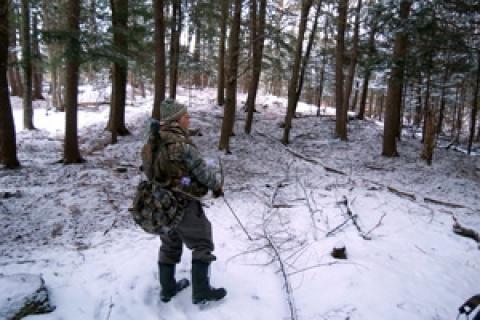
 This is, in my part of Ontario, the last week of the bow season for deer. As usual, it has been a week characterized by lots of snow and frigid cold. It might not seem like frigid cold but, believe me, when you are standing still as a statue on an inch or two of ice in a frozen cedar swamp, it is just that — especially when the wind howls through.
This is, in my part of Ontario, the last week of the bow season for deer. As usual, it has been a week characterized by lots of snow and frigid cold. It might not seem like frigid cold but, believe me, when you are standing still as a statue on an inch or two of ice in a frozen cedar swamp, it is just that — especially when the wind howls through.
I spent the weekend enjoying such conditions and, while I had several does pass by within reasonable range, no bucks (which is what our only remaining tag allows for) graced me with their presence.
At times like that, you get to thinking about how the cold affects the traditional archer.
One of the major things that the longbow or recurve hunter needs to consider is the effect on drawing. Stand still for an hour or two and try to draw that traditional bow and you might actually be in for a big surprise. Yup, those frozen muscles might not work the way they are supposed to.
I once sat in a frigid, late-December tree stand for a few hours and when my shot opportunity finally came, I couldn’t draw the bow I had drawn literally thousands of times before. So, I watched that deer pose ever so nicely at about 15 yards and then amble off to parts unknown — which was good, because no creature should be subjected to the language I then reverted to.
These days, to counter that, I draw my bow partially or fully about once every half hour or so when the weather is really frigid. It is movement I'd normally counsel against, but it helps muscles prepare and stay warmed up for the moment when the shot opportunity comes. So, look around before doing it and then get it out of the way quickly. This hasn't come back to haunt me yet.
The traditional archer is also affected is by the amount of clothes worn in conditions such as these. The combination of clothing and cold muscles can affect your draw — most often, they cause you to short draw because you alter your stance a bit with more clothes on and cold muscles don't always draw fully. If you are aware of this, however, you'll ensure it doesn’t happen.
Then there is the issue of gloves. Personally, I hate wearing them especially on my string hand. To avoid this, I'll often have my bow hand encased in a lighter glove that still allows me to grip the handle as I normally do. My string hand, complete with shooting glove will be keeping warm in my pocket until it is needed. Sometimes, I'll have a chemical pocket warmer working too in order to warm up both hands periodically.
If I must wear something to counter the cold on my shooting hand, it will be mittens, which I wear over my shooting glove and slip off when required.
Often face masks are used this time of year too. When that’s the case, make sure it doesn’t interfere with or alter your anchor point.
Otherwise, the traditional archer hunting in these frigid conditions needs to wear enough cloths to keep very comfortable. I prefer layering up with wool but, of course, there are all sorts of good quality winter hunting clothing out there. One thing I do is use a snug fitting vest as my last layer because it packs all the other clothing tight so it doesn’t interfere with the bowstring.
Lastly, you can't hunt in winter temperatures for long without a good pair of winter hunting boots and socks. If I had a dollar for every deer that was never seen because the hunter packed it in due to cold feet, I’m sure I’d be rich. Get the best boots and socks you can afford. You won’t regret it.
Comfort is important at all times of year — but especially if you are going to put venison on ice.
- 5268 views

